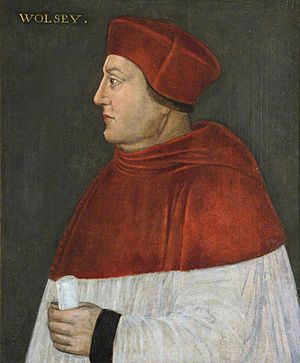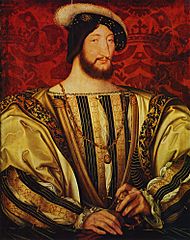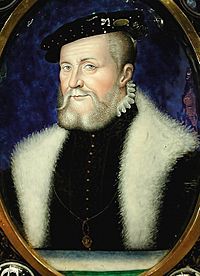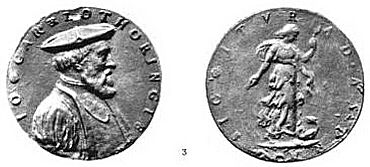Jean, Cardinal of Lorraine facts for kids
Quick facts for kids His Eminence Jean de Lorraine |
|
|---|---|
| Cardinal, Bishop of Metz | |
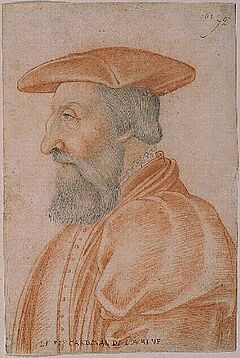 |
|
| Diocese | Metz |
| Appointed | 26 July 1501 |
| Reign ended | 10 May 1550 |
| Other posts | Cardinal-deacon of Sant 'Onofrio |
| Orders | |
| Created Cardinal | 28 May 1518 |
| Rank | Cardinal-deacon |
| Personal details | |
| Born | 9 April 1498 Bar-le-Duc, Lorraine |
| Died | c. 18 May 1550 (aged 52) Neuvy-sur-Loire, France |
| Nationality | French |
| Parents | René II, Duke of Lorraine Philippa of Guelders |
| Coat of arms | |
Jean de Lorraine (born April 9, 1498 – died around May 18, 1550) was an important French church leader. He was the third son of the Duke of Lorraine, a powerful family. Jean became a cardinal, which is a high-ranking official in the Catholic Church.
He held many important church positions during his life. These included being an archbishop in cities like Reims, Lyon, and Narbonne. He was also a bishop of Metz and managed several other church areas. Jean de Lorraine was a close friend and advisor to King Francis I of France. He was known for being the wealthiest church leader during Francis I's rule. He also held many church jobs at the same time, which was common then. He is one of several cardinals known as the Cardinal de Lorraine.
Contents
Biography
Jean was born in Bar-le-Duc, a town in Lorraine. He was the sixth of twelve children born to René II, Duke of Lorraine and his wife, Philippa of Guelders. His older brothers were Antoine, Duke of Lorraine and Claude, Duke of Guise. His mother later became a nun in 1520.
Becoming Bishop of Metz
When Jean was just a baby in 1500, he was chosen to become the helper and future successor to his uncle, Henri de Vaudemont-Lorraine, who was the Bishop of Metz. The church leaders in Metz agreed to this plan in 1500, and Pope Alexander VI approved it in 1501. This unusual plan was because Duke René wanted to keep the important bishopric of Metz within his family.
Bishop Henri officially stepped down in 1505, making Jean the Bishop of Metz. However, because Jean was so young, Henri continued to manage the church until he died later that year. After Henri's death, the church leaders in Metz managed the area until Jean turned twenty in 1518. Jean received a part of the church's income during this time.
In 1517, Jean de Lorraine was also chosen as the Bishop of Toul. He gave up this role in 1524. It is thought that Jean first met King Francis I at his brother Antoine's wedding in 1515.
Becoming a Cardinal
On May 28, 1518, when Jean de Lorraine was twenty years old, Pope Leo X made him a Cardinal-Deacon. This was a special meeting where new cardinals were chosen. Jean was the only cardinal chosen that day. Pope Leo X himself had become a cardinal at age thirteen, so he understood why the King of France wanted a young man like Jean to become a cardinal.
In January 1519, Jean was given the church of S. Onofrio in Rome, and his red cardinal's hat was sent to him in France. He visited Rome in April 1521. He had returned home before Pope Leo X died in December 1521, so he did not attend the meeting where the next Pope, Pope Adrian VI, was chosen.
In 1520, Jean de Lorraine was present at the Field of the Cloth of Gold. This was a famous meeting between King Francis I of France and King Henry VIII of England. Jean did not play a big political role at this time.
In 1521, Cardinal Jean de Lorraine was appointed Bishop of Thérouanne. He held this position until 1535. From 1522 onwards, he became a favorite of King Francis I and remained a close friend and advisor until the King's death in 1547.
Archbishop of Narbonne
On January 7, 1524, Cardinal Jean was named Archbishop of Narbonne. He held this important church position until he died.
In August 1527, King Francis I asked Cardinal de Lorraine to welcome and escort Cardinal Thomas Wolsey from England. Wolsey had come to France to discuss important matters with the King. Jean was not yet a main royal advisor, but he was being prepared for such roles. He was only twenty-nine years old.
The discussions led to a treaty between France and England. This treaty was about how both countries would react to the Sack of Rome (1527) in May 1527, when the Pope was captured. Cardinal de Lorraine was not involved in the main talks. However, he was one of four French cardinals who wrote to the Pope, saying they were praying for his release. He also saw the Chancellor, Antoine du Prat, receive his cardinal's symbols. Jean's growing importance was clear in 1528, when he was listed right after the King in terms of importance.
Abbeys: Cluny, Fécamp, Gorze
In 1528, King Francis I named Jean de Lorraine the leader of the Abbey of Cluny. He held this position until his death in 1550. The monks at Cluny had tried to choose their own leader, but the King and the Pope stepped in.
In 1530, Pope Clement VII allowed Cardinal de Lorraine to hold many church jobs and collect income from them.
In 1532, King Francis I also made Jean de Lorraine the leader of the royal abbey of Fécamp. He kept this abbey for the rest of his life. In 1534, Pope Paul III made Cardinal de Lorraine his special representative in the areas of Metz, Toul, and Verdun.
Jean sometimes gave up some of his church positions to his nephews. This was a way to help his family, the Lorraine family, keep control of various church benefits.
When Pope Clement VII died in 1534, Cardinal de Lorraine attended the meeting to choose the next Pope. He led the group of French cardinals. The cardinals eventually elected Pope Paul III in October 1534.
Royal Councillor
Jean de Lorraine became a regular member of the King's royal council in 1530. In 1536, he was sent to meet with Charles V, Holy Roman Emperor. He tried to explain what King Francis I was willing to do for peace, but Charles V was ready for war and rejected the offers. Jean then went to Rome to tell the Pope what was happening. He tried one last time to convince the Emperor to make peace, but it did not work. The Emperor's invasion of southern France was unavoidable.
A document from 1536 shows that Cardinal de Lorraine controlled the church areas of Metz, Toul, and Verdun. He also controlled the Abbey of Gorze and several castles. In 1537, he was given the Abbey of Saint-Médard in Soissons for two years.
When the King's son, Francis, died in 1536, the courtiers were afraid to tell the King. It was Cardinal de Lorraine who had to confirm the sad news to the King. The King then left it to the Cardinal to make the necessary arrangements.
In 1537, Jean de Lorraine was sent as an Ambassador to the Emperor to finalize a peace treaty. He returned to France in May. King Francis also nominated Jean de Lorraine to the church area of Lyon in 1537. He managed this area for about two years before giving it to Cardinal Ippolito d'Este.
Cardinal de Lorraine traveled with King Francis to Aigues-Mortes for a meeting with Emperor Charles in July 1538. He was present at some of their private discussions.
In 1540, Cardinal de Lorraine gave up his claims to the Duchy of Lorraine to his brother in exchange for money.
In 1542, King Francis approved Cardinal de Lorraine as the leader of the Abbey of Blanche-Couronne in Brittany.
A document from 1544 shows that the Cardinal controlled several abbeys, including Fécamp and Saint-Ouen. The King ordered trees from their forests to be cut down to build ships, and the Cardinal was told to deliver the wood.
Supporter of Arts and Learning
Cardinal de Lorraine was a generous supporter of art and learning. He was a friend and protector of important scholars like Erasmus, the poet Clément Marot, and the writer Rabelais. Some people believe that the character Panurge in Rabelais's famous book Gargantua and Pantagruel was based on Cardinal de Lorraine.
In 1527, thanks to Erasmus's suggestion, the Cardinal hired Claude Chansonette as his Chancellor.
In 1537, the famous artist Benvenuto Cellini was in Paris. He made a medal of Cardinal de Lorraine. One side of the medal showed a figure representing Truth, holding a mirror and a compass. The words on the medal meant "This is the way to the stars."
In 1549, Jean de Lorraine met a Franciscan friar named André Thevet. The Cardinal encouraged Thevet to travel to the Holy Land, which helped start Thevet's career as a writer about geography and cultures.
Choosing a New Pope (1549–1550)
Cardinal Jean de Lorraine took part in the meeting to choose a new Pope after Pope Paul III died in November 1549. His nephew, the Cardinal de Guise, was told by the King to support Jean de Lorraine first, then other French cardinals. Jean de Lorraine arrived at the meeting in December. In February 1550, Cardinal Giovanni Maria Ciocchi del Monte was elected and became Julius III.
Cardinal de Lorraine died from a stroke in Neuvy-sur-Loire on May 18, 1550, while returning to France from Italy. He was buried in Nancy. In his will, he left a large sum of money to help poor orphans in the areas of Metz, Toul, and Verdun.
See also
- Duke of Lorraine
- Dukes of Lorraine family tree
| Catholic Church titles | ||
|---|---|---|
| Preceded by Henri II of Lorraine-Vaudémont |
Bishop of Metz 1505–1550 |
Succeeded by Charles of Lorraine |
| Preceded by Hugh des Hazards |
Administrator of the diocese of Toul 1517–1524 |
Succeeded by Hector de Ailly-Rochefort |
| Preceded by Gaspard de Tournon |
Administrator of the diocese of Valence 1520–1522 |
Succeeded by Antoine Duprat |
| Preceded by François de Melun |
Bishop of Thérouanne 1521–1535 |
Succeeded by François de Créquy |
| Preceded by Louis of Lorraine |
Bishop of Verdun 1523–1544 |
Succeeded by Nicolas de Mercœur |
| Preceded by Ladislaus Dufau |
Administrator of the diocese of Luçon 1523–1524 |
Succeeded by Louis de Bourbon-Vendome |
| Preceded by Giulio di Giuliano de' Medici |
Archbishop of Narbonne 1524–1550 |
Succeeded by Ippolito d'Este |
| Preceded by Hector de Ailly-Rochefort |
Administrator of the diocese of Toul 1532–1537 |
Succeeded by Antoine Pellagrin |
| Preceded by Robert de Lenoncourt |
Archbishop of Reims 1533–1550 |
Succeeded by Charles of Lorraine |
| Preceded by Antoine Duprat |
Archbishop of Albi 1535–1550 |
Succeeded by "Cardinal de Guise" |
| Preceded by François de Rohan |
Administrator of the diocese of Lyon 1537–1539 |
Succeeded by Ippolito d'Este of Modena |
| Preceded by Marc-Antoine de La Rovère |
Administrator of the diocese of Agen 1538–1550 |
Succeeded by Matteo Bandello |
| Preceded by Louis d'Acigné |
Bishop of Nantes 1542–1550 |
Succeeded by Charles of Lorraine |
| Preceded by Antoine Pellagrin |
Administrator of the diocese of Toul 1542–1543 |
Succeeded by Toussaint de Hossey |


